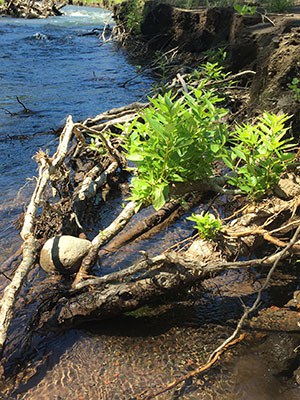If you’ve ever walked along one of Central Oregon's streams or rivers in late fall, you may have noticed the brilliant yellow leaves of the black cottonwood. It was the old, mighty cottonwoods that tower over the Whychus Creek at several Land Trust Preserves that got us wondering about the role these trees play in nature. Restoration ecologist Karen Allen offers this blog post to help shed some light.
Central Oregon’s native species, black cottonwood (Populus trichocarpa), is in the willow family (Salicaceae) and closely related to quaking aspen (Populus tremuloides). Native to the western U.S., British Columbia, and Alaska, the trees grow throughout Oregon along rivers and streams where sunlight is plentiful. West of the Cascades, black cottonwood forms extensive gallery forests (a forest that forms a corridor, such as along a river) in fertile alluvial soils on low elevation floodplains. East of the Cascades and in other in semi-arid regions, they tend to be more restricted to protected valley bottoms where groundwater is recharged by streams. Both the Oregon Flora Project and NRCS PLANTS database provide visuals of black cottonwood distribution.
Cottonwoods perform many important functions along our streams and rivers, bolstering life both in and out of the water. They are a keystone species, one that has a disproportionately large impact on ecological systems relative to their abundance on the landscape. Roots help stabilize streambanks and floodplains. Wood that falls into the channel helps shape it, trap sediment, and provide cover for fish and other aquatic species. A cottonwood gallery provides shade and moderates stream temperatures. The branching structure and cavities that often result from heart rot in mature cottonwood stands provide nesting habitat for birds and cover for a variety of wildlife, including deer, elk, and beaver. Foliage also provides leaf litter to the stream that becomes food for aquatic invertebrates such as stoneflies, mayflies, and caddisflies.
In the past several decades, cottonwood communities have declined throughout their range. Changes to the natural hydrologic cycle can decrease cottonwood seedling success (described below) and increase the mortality of older trees. Water diversions and the effects of dams that alter flood flows, the rate of sediment deposition, and movement of stream channels can also cause cottonwoods to dwindle. Browsing by deer and elk can limit cottonwood regeneration. Channelization, such as that which historically occurred along Whychus Creek, leads to channel incision, a drop in adjacent groundwater levels, and a lack of floodplain connectivity that’s crucial for the deposition of fine sediment that cottonwood seeds need to flourish. 
If sexual reproduction by seeds isn’t successful, cottonwoods have several asexual reproduction strategies to bolster their response to disturbance. Due to its high levels of rooting hormones, black cottonwood sprouts readily from stumps and roots as well as from branches that fall to the ground. Floods scour shallow roots, promoting the production of advantageous shoot suckers from shallow roots. Small shoots with green leaves naturally shed and root. ‘Flood training’ is another variation of asexual reproduction where the parent trunk topples and is buried by sediment during a flood event. This triggers shoot suckering that produces a line of new trunks that emerge from the fallen one. With all these sprouting strategies, it’s no wonder cottonwoods are so easily grown from stem cuttings.
Cottonwood gallery forests are being restored throughout the West. The combination of restoring nature channel processes and system attributes helps restore conditions conducive to the flourishing of cottonwoods. By restoring natural channel processes and flow regimes, reconnecting streams to their floodplains, restoring natural patterns of sediment transport and deposition, and raising groundwater levels adjacent to the stream, we can restore healthy diverse streamside plant communities rich with cottonwoods such as those found along Whychus Creek.
Sources and more information:
- NRCS Plant Guide: Black Cottonwood
- Johnson, DH and TA O’Neil. 2001. Wildlife-Habitat Relationships in Oregon and Washington. Corvallis, OR: Oregon State University Press. 736 pp.
- Stewart BR, Goater LA, Mahoney JM, Pearce CM, and DG Smith. 2007. Floods, fire, and ice: disturbance ecology of riparian cottonwoods. Can. J. Bot. 85: 1019–1032. doi:10.1139/B07-073
- Stewart BR, JH Braatne, and FR Hughes. 2003. Ecophysiology of riparian cottonwoods: stream flow dependency, water relations and restoration. Tree Physiology 23, 1113–1124.
 Karen Allen has more than 25 years of experience in habitat restoration, specializing in wetland and stream restoration. A plant ecologist at heart, Karen served as the Land Trust's first land steward caring for our protected lands. Lucky for us, she has continued to be involved as our plant specialist for many Land Trust restoration projects.
Karen Allen has more than 25 years of experience in habitat restoration, specializing in wetland and stream restoration. A plant ecologist at heart, Karen served as the Land Trust's first land steward caring for our protected lands. Lucky for us, she has continued to be involved as our plant specialist for many Land Trust restoration projects.
Learn more:


